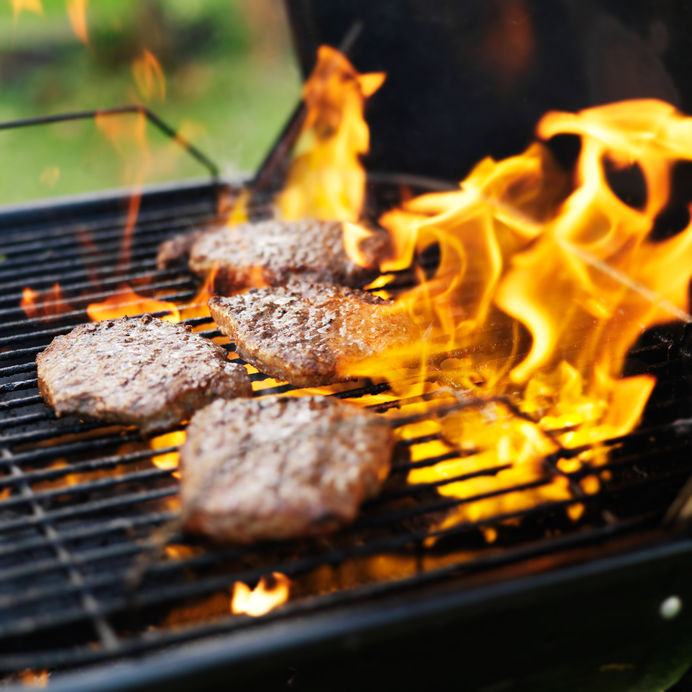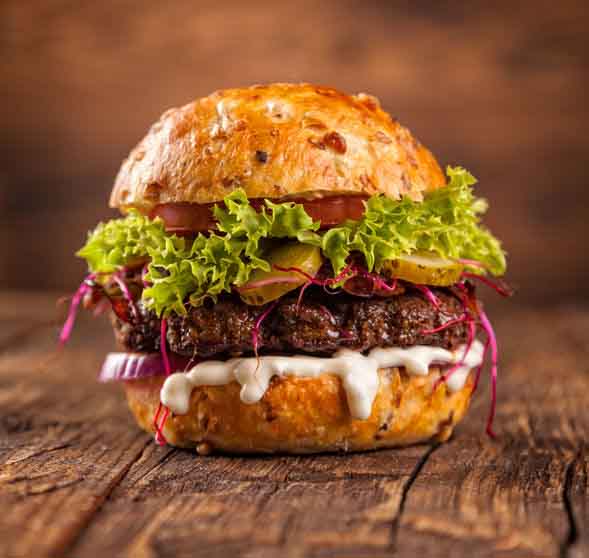The Perfect Grilled Burger

If you’re using ground beef from a local source, you’re already on your way to a great tasting burger, since locally produced beef is superior in flavor to conventional beef. You can mix in seasonings like herbs, bacon bits, cheese, sun dried tomatoes, steak sauce, Worcestershire sauce, etc. but just a sprinkling of salt is perfectly fine.
Shaping the patties
When shaping your burgers, make sure they are all the same size – aim for about 6 oz. per patty – so they will all cook at the same rate and you won’t end up with several that are overcooked because they were smaller. Make them thin so they cook up faster. Burgers shrink while cooking and puff up into fat pucks unless you make them thin, or, unless you make the middle of the patty thinner than the outer edge. To do this, simply make a well in the center with your thumb. Give it a liberal sprinkling of salt and place in refrigerator if your grill isn’t ready.
Heating the grill
The grill should be at about medium heat. Once hot, scrape and clean the grill with a grill brush. Oil the grill with a paper towel soaked in cooking oil, holding the paper towel with tongs. A flaming grill (like in the photo) is not good because then you will simply char the outsides of the burger and the inside will still be raw. Sometimes it’s difficult to cook without causing flare-ups due to the dripping fat. You just have to monitor it and maybe move the burgers away from the flames. Have a spray bottle with water handy to control flare ups. But the less you fiddle with them the better. Leave them undisturbed for about 3 minutes so they get good grill marks and don’t stick. And be sure NOT to press or poke the burger lest you lose all the wonderful juices.
Cooking the burgers
How long should you cook them? The U.S. Department of Agriculture recommends cooking ground beef all the way through (to a 160-degree internal temperature). That caution comes in response to periodic outbreaks of food-borne illnesses caused by commercially processed ground beef. But if you are using local beef, your chance of having a tainted burger is slim to zero, since our smaller, local farms are not plagued by the problems inherent in CAFOs (concentrated animal feeding operations). If you like your burger rare, you can have it your way, with a very low risk of food-borne illness, as long as it’s local beef. You can check doneness by touch: a little give for medium and just barely firm for well-done.
The Bun
To toast or not to toast the bun… A toasted bun adds the perfect light crunch to a burger and holds up better to wet toppings. Lay your bun on the top rack of the grill a few minutes before the burgers are done.
Toppings
As for toppings, you are limited only by your imagination. But here are some general thoughts:
- Tomato slices are only good if they are in-season and ripe. Bland, hothouse tomatoes just add wetness without adding any flavor.
- Sweet or red raw onion is preferable to sharp cooking onions.
- Pan-grilled onions are awesome on burgers, as are fried mushrooms.
- If you must have cheese on your burger, the sky is the limit here too but cheddar seems to be the best complement. Add a thin slice several minutes before cooking time is up.
- Avocado tastes good with just about everything including burgers.
- You can't go wrong with crispy bacon slices either.
- Crispier lettuce also adds a nice crunch but spicy greens like arugula or watercress are wonderful too.
Here’s to a great grilling season, graced by the best burgers you’ve ever had!
